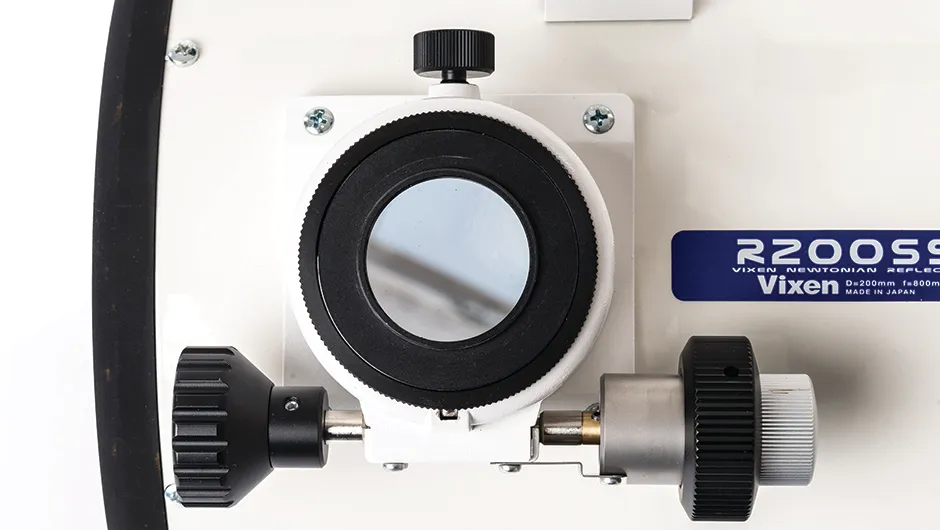Few things are more frustrating than the British weather – fantastically clear one minute, sodden and cloudy the next.
To take advantage of any window of good conditions, no matter how brief, it’s a boon to have a fast scope with a reasonable aperture that is both quick to set up and allows you to capture good images.
This is a role the Vixen R200SS Newtonian reflector with Corrector PH fills admirably.
The problem with fast reflectors has always been their ability to maintain good collimation.
While their speed makes them attractive, it can also make them infuriating, as the slightest shift in the position of either mirror can result in a spoiled image.
Vixen has tackled this problem head-on, with a substantial spider vane and closed primary cell.
The R200SS handbook boldly states that the scope has been factory collimated and shouldn’t need any further attention.
After star testing the telescope, it has to be said that we were pleasantly surprised. Even at high magnification, its out-of-the-box collimation looked perfect.
Vixen will provide a DIY collimation guide if required, or will recollimate it for you – details are available via its dealers.
The other element of this package, also available as an add-on for existing R200SS owners, is an exciting new corrector – the Vixen Corrector PH.
It promises round stars right to the corners of the image, and takes the already speedy f/4 R200SS down to an impressive f/3.8, ideal for making the most of limited clear skies.
This telescope is among our pick of the best telescopes for astrophotography

Expectations met
With an eyepiece in place we couldn’t resist trying a few visual targets, and the wide field of view was perfect for observing star clusters.
Particularly impressive was the Double Cluster in Perseus, with sharp, pinpoint stars right to the edge of the view.
Although this telescope is designed for astrophotography, it comes with a 1.25-inch eyepiece adaptor and offers rewarding views, especially of larger objects.
Just before putting the camera in place we had a good look at the optics.
A Ronchi grating gave an almost textbook parallel pattern, and at high magnification the mirrors returned a smooth and precise Airy disk.
There was the slightest hint of astigmatism at high magnification, but nowhere near enough to degrade the star image at focus, whether using an eyepiece or camera.
Indeed, we came out of these visual tests with high expectations for the telescope when used for astrophotography, and we were not disappointed.
Using a DSLR and Bahtinov mask, we found focus to be sharp across the whole field.
The corrector maintains good colour across the red, green and blue wavelengths, meaning that when used with a DSLR or colour CCD, you won’t have the issue of bloated blue stars.
In fact the images produced from the R200SS and Corrector PH in combination were very good indeed, with sharp, nicely shaped stars even at the edges of the frame.
Fast scopes have a tiny depth of focus, and therefore require precise focusing.
The dual-speed rack and pinion focuser supplied, whilst not silky smooth, felt firm and dependable, and more than capable of allowing the miniscule movements necessary.
As the outside temperature dropped, the focus required tweaking, but that, remarkably for an f/3.8 Newtonian, was all the adjustment needed to achieve great quality images, even after several weeks of use.
Perhaps the ultimate compliment for a reflecting telescope would be that is as easy to use as a refractor.
With the R200SS and Corrector PH combination, Vixen is very close indeed to that standard and has made it easier than ever to take high quality astro images in a short time.
Wynne’s a winner
The three-element Corrector PH is of the respected Wynne design, and fits within the focuser tube.
A male T-thread adaptor enables a DSLR camera with a T-ring to attach directly to the telescope.
With more and more astrophotographers using DSLRs, the large corrected field of the R200SS and Corrector PH is a match that will allow you to take great astrophotos in just one session, even with just an hour or two of clear skies.
Of course, CCD camera users are not left out, and when used with narrowband filters the fast f/3.8 focal ratio really helps to pull in that faint detail, making it easier and faster to achieve deep and rich images.
During our tests we found the Corrector PH produced good quality star images right out to the corners with our DSLR camera.
Zooming right in reveals a very slight ‘comet’ shape to the stars in the corners, but a large improvement over previously available correctors, and in our view, more than acceptable in the overall image.
Dual-speed focuser
The rack and pinion dual-speed focuser is strong and precise, with a fine focus knob that is easy to use with cold hands and a locking knob that offers a firm hold. The focuser held all of our imaging equipment – including a filter wheel, off-axis guider and camera – without drooping or flexing.
Lightweight tube
Constructed of aluminium, the baffleless tube is lightweight and easy to handle, with a matt finish internally to prevent stray reflections. Its dimensions are 690mm in length and 234mm in diameter, and it is supplied with tube rings, a carry handle and fittings for accessories.
Covered primary mirror cell
A welcome touch is the steel cover at the rear of the scope. Matt black to help dissipate internal heat, the cover prevents stray light entering through the rear of the mirror and spoiling the image. Even a torch shining directly on this cover had no effect on image capture.
Illuminated finderscope
The 7x50mm finderscope is a straight-through design with a variable-brightness illuminated reticule. The supplied bracket kept the finderscope precisely aligned when adjusting the reticule switch. It was also easy to focus, even when wearing glasses.
Spider vane
The robust design eliminates the need for constant collimation, holding the secondary mirror steady in all positions. As one of the trickiest aspects of using fast Newtonians, we didn’t miss fiddling about with screwdrivers dangled over expensive mirrors in the dark.
Vital stats
Price: £1699.00
Aperture: 200mm (8 inches)
Focal Length: 760mm (f/3.8)
Weight: 5.3kg
Supplier: Opticron
Telephone: 01582 726522
Website:www.vixenoptics.co.uk
This review originally appeared in the February 2016 issue of BBC Sky at Night Magazine.
